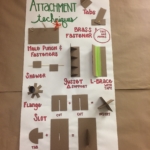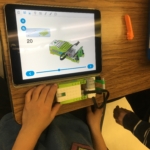A Framework for Makerspaces
When designing a makerspace or STEAM program, it’s helpful to have a framework for decision making. One of the easiest to use is the Purpose-People-Parts Making+Learning framework from the Children’s Museum of Pittsburgh and the Institute of Museum and Library Services.
Makerspace Material Philosophy
Start slowly. You can do a lot with cardboard and a hot glue gun station. Do not invest in large digital devices or fabrication tools until you have a need for them. Expensive laser cutters and 3D printers will sit idle if schools haven’t designed a use for them, or if devices break and there are no plans or staff to fix them. Set up an open, adaptable space with as much donated and recycled material as possible. Use cardboard boxes for storage. Watch how students and staff use the space. Build out as they demand more.
Supplies
Starter Makerspace Materials
Holding Things Together
- Scotch Tape
- Masking Tape
- Glue Sticks
- Elmer’s Glue (one-gallon)
- Hot Glue Guns (low temp)
- Hot Glue Sticks
Paper (Donated)
- Toilet paper tubes
- Cardboard
- Paper Towel tubes
Plastics
- Plastic Shapes (recycled from old math manipulatives)
- Straws (large)
- Straws (small)
- Translucent plastics (recycled)
- Transparent plastics (recycled from bottles, food containers, etc.)
Wood
Tools
- Heavy Duty Hole Punch
- Scissors small
- Scissors large
- Rulers (4 pack)
- Cardboard Saws
- Cardboard Cutter
- Box Cutter (for adults, only)
- Pencils
- Colored Pencils
- Crayons
- Pencil Sharpener (electric)
Storage and Labeling
Advanced Makerspace Materials
Holding Things Together
- Scotch Tape
- Masking Tape
- Glue Sticks
- Elmer’s Glue (one-gallon)
- Hot Glue Guns (low temp)
- Hot Glue Sticks
- Binder Clips – Small
- Binder Clips – Medium
- Binder Clips – Large
- Brass Brads
- Paper Clips (regular)
- Paper Clips (large)
Paper
- Toilet paper tubes
- Cardboard
- Paper Towel tubes
- Construction Paper
- Tissue Paper (various colors)
- Index Cards (3″x 5″)
- Index Cards (4″ x 6″)
Plastics
- Plastic Shapes (recycled)
- Straws (large)
- Straws (small)
- Translucent plastics (recycled)
- Transparent plastics (recycled)
- Shaft Propeller (fits DC motors for Fan Carts)
- Project Wheels (1/8″ hole for Fan Carts)
Wood
- Coffee stirrers (wooden)
- Corks (donated)
- Toothpicks
- Popsicle Sticks (regular)
- Popsicle Sticks (Jumbo)
- Dowels 100 pack (1/4 ” x 6″)
- Dowels 100 pack (1/8 ” x 12″)
Tools
- Trauma Shears
- Heavy Duty Hole Punch
- Scissors small
- Scissors large
- Rulers (4 pack)
- Cardboard Saws
- Cardboard Cutter
- Box Cutter (for adults, only)
- Pencils
- Colored Pencils
- Crayons
- Pencil Sharpener (electric)
Decorative
- Yarn (Donated)
- Pom Poms
- Googly Eyes
- Beads (Various shapes)
- Q-Tips
- Cotton Balls
- Feathers
- Pipe cleaners
Storage and Labeling
Electronics
- AA battery holders (single)
- AA rechargeable batteries
- DC Motors (These run off a single AA.)
- DC Gear Motors
- Copper Tape
- 10mm Diffused LEDs
- Wires w/ alligator clips (soldered)
- Coin cell batteries (3v)
- Battery Charger AA
- 9 Volt batteries with charger
Kits
Devices
Tools
- All Purpose Screw Driver (flathead for Kibo battery pack)
- Wire Stripper (self-adjusting)


